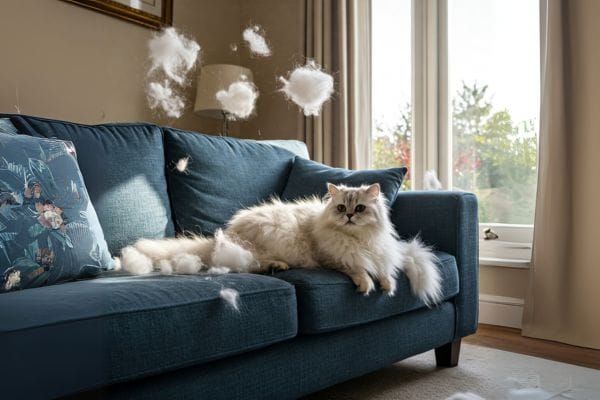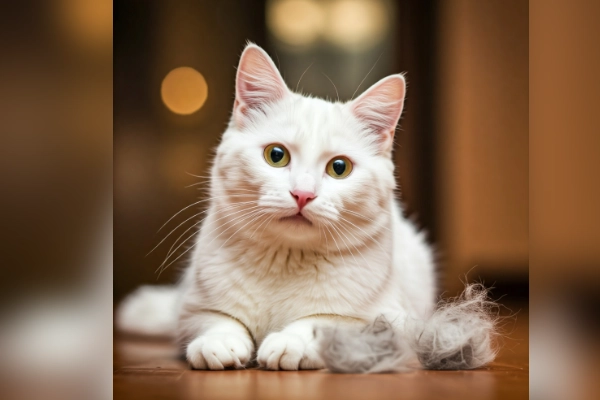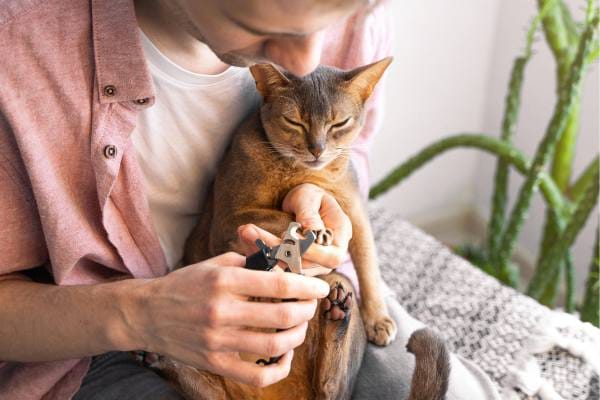How to Stop Cat Shedding: Dealing with cat hair everywhere? Shedding is natural, but excessive fur loss can be frustrating and a sign of health issues. This guide offers 7 vet-approved tips to help you manage your cat’s shedding effectively. From regular brushing and balanced nutrition to stress management and professional grooming, you’ll learn how to reduce loose fur while keeping your cat healthy and happy. Whether you have a long-haired Persian or a short-haired domestic cat, these practical strategies will make a noticeable difference. Say goodbye to constant cleaning and hello to a healthier, shinier coat for your feline friend!
Understanding Cat Shedding Biology
To understand how to manage your cat’s shedding, you need to know the basics of why cats shed in the first place. Your cat’s fur serves multiple purposes, including temperature regulation, protection, and sensory function. Each hair grows from a follicle and goes through natural growth cycles, which explains why you find fur around your home.
Natural Shedding Cycles
There’s a natural rhythm to your cat’s shedding pattern. Most cats shed year-round but experience two major shedding periods: spring (losing winter coat) and fall (preparing for winter coat). During these times, you’ll notice increased fur loss as your cat’s body adapts to seasonal changes.
Factors Affecting Cat Shedding Patterns
Clearly, several elements influence how much your cat sheds. These include:
- Indoor vs. outdoor living
- Diet and nutrition
- Stress levels
- Breed type
- Age and hormones
Knowing these factors helps you better manage your cat’s shedding.
With proper understanding, you can see how these factors work together. Indoor cats often shed year-round due to artificial lighting and controlled temperatures. Your cat’s diet plays a huge role in coat health – poor nutrition can lead to excessive shedding. Stress can trigger sudden increased shedding, while certain breeds naturally shed more than others. Knowing these patterns helps you create an effective shedding management plan.
Common Health-Related Cat Shedding Issues
While some shedding is normal, excessive hair loss might signal health problems. Watch for signs like bald patches, skin irritation, or unusual shedding patterns. These could indicate underlying issues that need veterinary attention.
Factors that might indicate health-related shedding include allergies, parasites, thyroid problems, or skin infections. Some cats develop stress-related excessive grooming habits, leading to hair loss. If you notice sudden changes in shedding patterns or skin problems, it’s important to consult your vet. Knowing the difference between normal shedding and health-related hair loss helps you take better care of your cat.
Tip 1: Regular Brushing
Even the most basic grooming routine can make a huge difference in reducing your cat’s shedding. Regular grooming not only removes loose fur before it ends up on your furniture but also helps distribute natural oils throughout your cat’s coat, promoting healthier skin and fur.
Choosing the Right Brushing Tools

Choosing the right brush is key to effective grooming. For short-haired cats, a fine-toothed metal comb or rubber brush works best. Long-haired cats need a wide-toothed comb and slicker brush to prevent painful mat formation. You’ll also want to keep a pin brush handy for general maintenance.
Proper Brushing Techniques
Clearly, the way you brush your cat matters as much as the tools you use. Always brush in the direction of fur growth, starting from the head and working your way down to the tail. Be extra gentle around sensitive areas like the belly and chest.
Another important aspect of proper brushing is maintaining a calm environment. Take breaks if your cat becomes stressed, and reward them with treats to create positive associations with grooming time. Use gentle, steady strokes and avoid pulling on tangles or mats.
Grooming Frequency Guidelines
Clearly, how often you groom your cat depends on their coat type and shedding patterns. Short-haired cats typically need brushing 2-3 times per week, while long-haired cats require daily grooming to prevent matting and excessive shedding.
For instance, you might need to increase grooming frequency during seasonal changes, particularly in spring and fall when cats naturally shed more. If you notice your cat grooming themselves excessively or developing hairballs, it’s a sign that more frequent brushing is needed. Morning or evening grooming sessions often work best when your cat is naturally more relaxed.
Tip 2: Balanced Nutrition
Unlike many temporary solutions, proper nutrition forms the foundation of your cat’s coat health. What you feed your cat directly impacts their fur quality and shedding patterns. A well-balanced diet rich in specific nutrients can significantly reduce excessive shedding and promote a healthier, shinier coat.
Essential Nutrients for Healthy Fur

Role of proteins and fats cannot be overlooked in maintaining your cat’s coat health. Your cat needs high-quality animal protein and omega-3 and omega-6 fatty acids to develop and maintain healthy fur. These nutrients help create new hair cells and keep your cat’s skin moisturized, naturally reducing shedding.
Recommended Diet Modifications
Diet changes can make a big difference in managing your cat’s shedding. Consider switching to premium cat food that lists real meat as the first ingredient. You should avoid foods with artificial preservatives and fillers, as these can trigger allergies and increase shedding.
Understanding your cat’s specific dietary needs is imperative for managing shedding. If your cat shows signs of food sensitivities, such as excessive shedding or skin irritation, you might need to try a limited-ingredient diet. Always introduce new foods gradually over 7-10 days to prevent digestive issues.
Supplements and Their Benefits
Healthy coat supplements can enhance your cat’s fur quality when diet alone isn’t enough. Fish oil supplements, biotin, and zinc can help reduce shedding and improve coat shine. However, always consult your vet before starting any supplement routine.
Health benefits of supplements extend beyond just coat improvement. The right supplements can support your cat’s immune system, improve skin condition, and help maintain overall wellness. However, be careful not to overdose – too many supplements can be harmful to your cat’s health.
Tip 3: Hydration Strategies
Not many pet owners realize that proper hydration plays a vital role in reducing cat shedding. When your cat stays well-hydrated, their skin remains moisturized, which helps maintain a healthy coat and reduces excessive shedding. You’ll notice a significant difference in your cat’s fur quality when they get enough water daily.
Water Intake Requirements
Now let’s talk numbers: your cat needs about 3.5 to 4.5 ounces of water per 5 pounds of body weight each day. For example, if your cat weighs 10 pounds, they should drink 7-9 ounces of water daily. This includes water from both drinking and wet food sources.
Encouraging Drinking Habits
The easiest way to get your cat to drink more water is by making it more appealing. You can do this by placing multiple water bowls throughout your home, using pet fountains that provide moving water, or even adding a splash of low-sodium chicken broth to their water.
Habits can be improved by keeping water bowls clean and fresh daily. Consider your cat’s preferences – some cats prefer ceramic bowls over plastic, while others might like wide, shallow dishes that don’t touch their whiskers. Never use milk as a water substitute as many cats are lactose intolerant.

PETLIBRO App Monitoring Cat Water Fountain, 2.5L/84oz
• Easy Cat Care: Easily set a hydration goal in the app, and the PETLIBRO Dockstream App Monitoring Cat Water Fountain will track your cat’s drinking volume, frequency, and time.
• Easy to Clean & Install: The cat fountain features a detachable water tank design for easy refilling.
• Perfect For Your Cat: Made of 304 food-grade stainless steel tray and BPA-free materials
Alternative Hydration Sources
Little do many cat owners know that wet food can provide up to 80% of your cat’s daily water needs. You can mix wet and dry food or add water to dry kibble to increase your cat’s moisture intake naturally.
This approach to hydration can include offering ice cubes during hot days, feeding water-rich treats like small pieces of watermelon (without seeds), or incorporating bone broth into their diet. Always introduce new foods gradually to avoid digestive issues, and consult your vet before making significant changes to your cat’s diet.
Tip 4: Manage Your Cat’s Stress
Many cats experience increased shedding when they’re stressed, making stress management an necessary part of controlling hair loss. Your cat’s emotional well-being directly affects their physical health, including how much they shed. Understanding and managing your cat’s stress levels can help reduce excessive shedding and create a healthier environment for both you and your pet.
Identifying Stress Triggers
If your cat shows signs of stress like excessive grooming, hiding, or increased shedding, you need to identify what’s causing these behaviors. Common triggers include changes in routine, new pets, loud noises, or unfamiliar visitors. Keep a diary of when your cat seems most stressed and look for patterns. This will help you understand what situations cause your cat anxiety and increased shedding.
Creating Calm Environments
An ideal cat environment includes quiet spaces, elevated resting spots, and consistent routines. Your cat needs places where they can retreat when feeling overwhelmed. Set up cat trees, window perches, or dedicated “safe rooms” where your cat can relax undisturbed.
To enhance your cat’s sense of security, maintain regular feeding times and play sessions. Add calming elements like soft bedding, familiar scents, and gentle background music. Avoid sudden changes in your home’s layout or routine, as these can trigger stress-related shedding.
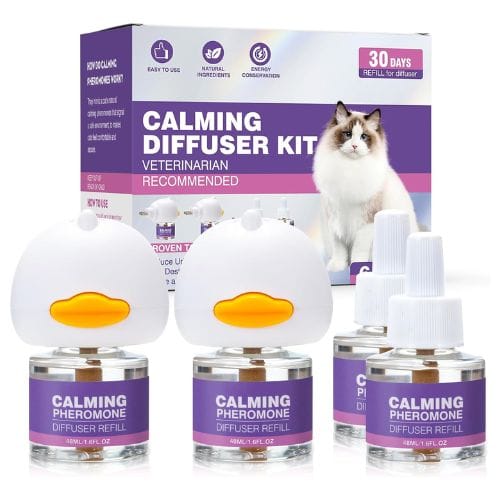
Cat Calming Pheromone Diffuser
• The cat pheromone diffuser is ideal for soothing cats. The cat-calming diffuser has broad coverage and provides superior, longer-lasting pheromone delivery.
• Cat pheromone diffuser is the veterinarian-recommended solution to help reduce tension, fights, and stress among cats
• Effectively relieves fear or stress from heat, noise, traffic, travel, veterinary visits, pet loneliness, fireworks, thunderstorms, separation anxiety, and more.
Behavioral Modification Techniques
Techniques for reducing stress-related shedding include positive reinforcement, gradual exposure to new situations, and consistent daily routines. You can help your cat feel more secure by rewarding calm behavior and providing regular playtime.
The key to successful behavioral modification lies in patience and consistency. Start with short training sessions and gradually increase duration as your cat becomes more comfortable. Use treats and praise to reward desired behaviors, and never punish your cat for stress-related responses, as this can make shedding worse.
Tip 5: Parasite Prevention
All cats need protection from parasites that can affect their coat health and shedding patterns. Your cat’s excessive shedding might be a sign of parasitic infestation, which requires immediate attention to prevent further complications and maintain a healthy coat.
Common Parasites Affecting Coat Health
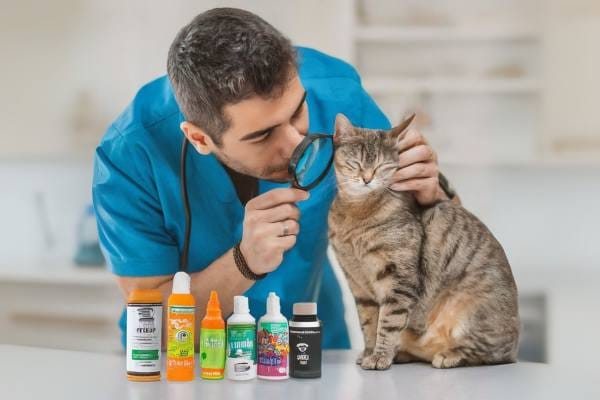
For cats, the most common parasites that affect coat health include fleas, mites, and ringworm. These unwanted guests can cause your cat to scratch excessively, leading to hair loss and increased shedding. You might notice your cat’s coat becoming patchy or dull, which are clear signs of parasite problems.
Prevention Methods
On a regular basis, you should use vet-approved preventive medications to protect your cat from parasites. Your veterinarian can recommend the best monthly treatments based on your cat’s age, weight, and lifestyle.
Affecting your cat’s overall health, proper parasite prevention includes keeping your home clean, regularly washing your cat’s bedding, and maintaining a consistent grooming routine. You should also keep your cat indoors when possible to reduce exposure to parasites from other animals.
Treatment Options
Any signs of parasites require immediate veterinary attention. Your vet will conduct tests to identify the specific parasite and prescribe appropriate treatments, which may include topical medications, oral medications, or medicated shampoos.
Another important aspect of treatment is following through with the complete course of medication. You should never skip doses or stop treatment early, even if your cat’s symptoms improve. Your vet might recommend follow-up appointments to ensure the parasites are completely eliminated and your cat’s coat is returning to normal.
Tip 6: Professional Grooming Considerations
Once again, managing your cat’s shedding might require more than just home care. Professional grooming services offer specialized treatments and expert handling that can significantly reduce shedding and maintain your cat’s coat health. Regular professional grooming can help establish a maintenance routine that works best for your cat’s specific needs.
When to Seek Professional Help
Even the most dedicated pet parents might need expert assistance when dealing with excessive shedding. You should consider professional help if your cat has matted fur, shows signs of skin problems, or if home grooming becomes too challenging. Professional groomers can spot potential health issues early and provide proper grooming techniques tailored to your cat’s coat type.
Grooming Service Types
- Full-service grooming (bath, brush, nail trim)
- De-shedding treatments
- Lion cuts for severely matted cats
- Spot cleaning services
| Service | Benefits |
|---|---|
| Full Groom | Complete coat care |
| De-shed | Reduces loose fur |
| Lion Cut | Fresh start for matted cats |
| Spot Clean | Targeted problem areas |
| Express Groom | Quick maintenance |
Now, professional groomers offer various services to address different shedding concerns. Each service is designed to target specific grooming needs while ensuring your cat’s comfort and safety. Assume that regular professional grooming can reduce shedding by up to 90%.
- Specialized tools for different coat types
- Professional-grade products
- Expert handling techniques
- Stress-free environment
| Tool Type | Purpose |
|---|---|
| Slicker Brush | Remove loose fur |
| Grooming Clippers | Trim matted areas |
| De-shedding Tools | Reduce undercoat |
| Grooming Dryer | Remove loose fur |
| Combs | Detail work |
Plus, professional groomers use specialized techniques and tools that aren’t typically available for home use. These services can provide deeper cleaning and more effective de-shedding results. Assume that professional grooming can extend the time between needed grooming sessions.
Cost-Benefit Analysis
Clearly, investing in professional grooming services might seem expensive at first, but the benefits often outweigh the costs. Regular professional grooming can reduce home cleaning time, improve your cat’s coat health, and prevent costly medical issues related to poor coat maintenance.
Help your cat maintain a healthy coat by weighing the pros and cons of professional grooming. While basic grooming services might cost between $50-100 per session, you’ll save money on cleaning supplies and potential vet bills in the long run. Professional grooming can also help reduce allergic reactions in sensitive family members by removing excess fur and dander more effectively.
Tip 7: Medical Interventions
Once again, while grooming and diet play major roles in managing your cat’s shedding, sometimes medical attention is necessary. Your veterinarian can help identify underlying health issues that might cause excessive shedding and recommend appropriate treatments.
Regular Veterinary Check-ups
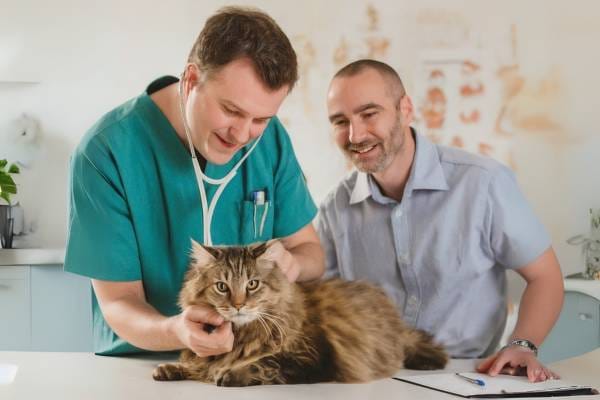
Now, taking your cat for regular vet visits is one of the best ways to prevent and control shedding problems. Your vet can spot early signs of skin conditions, hormonal imbalances, or other health issues that might increase shedding before they become serious problems.
Medical Treatments for Excessive Shedding
On the medical front, your vet might recommend treatments like anti-inflammatory medications, hormone therapy, or special medicated shampoos if your cat’s shedding is linked to a health condition.
Understanding that medical treatments vary based on the underlying cause is important. Your vet might prescribe oral medications for allergies, topical treatments for skin infections, or supplements for nutritional deficiencies. These treatments can significantly reduce abnormal shedding and improve your cat’s overall coat health.
Warning Signs to Watch For
Little changes in your cat’s shedding pattern might signal bigger health issues. Watch out for bald patches, skin irritation, excessive scratching, or any sudden increase in shedding, as these could indicate a medical problem that needs attention.
Watch your cat carefully for these additional warning signs: changes in appetite, lethargy, aggressive grooming, or visible skin problems. If you notice any of these symptoms along with unusual shedding, contact your vet immediately. Early detection and treatment can prevent more serious health issues and help maintain your cat’s coat health.
Environmental Factors
Despite your best grooming efforts, environmental conditions play a huge role in your cat’s shedding patterns. Your home’s indoor climate directly affects your cat’s fur health and shedding cycle. The following factors can help you manage excessive shedding:
- Temperature changes
- Humidity levels
- Air quality
The right balance of these elements can reduce excess shedding by up to 30%.
Temperature Control
| Ideal Indoor Temperature | 65-75°F (18-24°C) |
| Night Temperature | 60-70°F (15-21°C) |
While maintaining a steady indoor temperature is important, sudden temperature changes can trigger excessive shedding. You should keep your home’s temperature consistent throughout the day to help regulate your cat’s natural shedding cycle.
Humidity Levels
Control your home’s humidity levels between 40-50% to help manage your cat’s shedding. Too much humidity can lead to skin problems, while too little can cause dry skin and increased shedding.
Factors affecting indoor humidity include weather, heating/cooling systems, and daily activities. You can use a humidifier or dehumidifier to maintain optimal levels, which will help keep your cat’s skin healthy and reduce excessive shedding.
Air Quality Management
On top of temperature and humidity, good air quality is imperative for reducing cat shedding. Using air purifiers and regularly changing your HVAC filters can remove allergens and dander from your home’s air.
Management of your home’s air quality includes regular filter changes every 2-3 months, keeping windows open when possible for fresh air circulation, and using pet-safe air purifiers. These steps help create a healthier environment for both you and your cat, leading to less shedding and better respiratory health.
If you want to know more about the care of your little fur friend, please check out our article:
Ultimate Cat Care Guide: Everything You Need to Know in 2025
Final Words
Upon reflecting, managing your cat’s shedding requires a mix of proper grooming, nutrition, and care. By following these vet-approved tips, you can significantly reduce the amount of cat hair around your home and help your feline friend maintain a healthier coat. While you can’t completely stop shedding, as it’s a natural process, your consistent efforts in brushing, providing a balanced diet, and keeping your cat healthy will make a noticeable difference. With these methods in place, you’ll spend less time cleaning up fur and more time enjoying your cat’s company.

